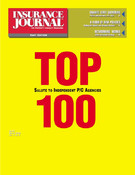Auto, home and small business policies are virtually identical, according to most of the people who buy them. It doesn’t take a huge investment in market research to learn this, just some time in the field. So, what can you as an agent do about it? How can you stop being identical? It isn’t easy, especially when you are selling indistinguishable policies, from the same companies, as the office down the street. There is an answer, and it resides under the general heading of product differentiation.
To break out of the sameness loop, you have to do something that’s out of the ordinary. Maybe you can build up your client service operations by adding more CSRs, improving their training, and extending your hours. This is always helpful. But, your competition can do the exact same thing. And when they do it, then “quality service” becomes just another commodity in the eyes of the prospect.
Another option is to become more assertive in your agency’s general advertising. It, too, can distinguish your operation. However, your rivals can place competing ads of their own, in the exact same media. There are no barriers holding them off. In both cases, over time, you’ll be right back where you started from, looking for new ways to differentiate your offers of indemnity.
There is a practical solution to this common dilemma. It will help you to grow in your community and beyond. It’s a marketing technique called “policy repackaging.” The concept involves the bundling of standard insurance contracts and endorsements with target-specific agency services, to create a new and synergistic agency-only program. In essence, you’ll be inventing and naming your own competitive advantage. You can then use this advantage to become a known entity to carefully identified prospects groups. However, this approach can only work if you focus your marketing efforts on promoting the benefits of doing business with your agency and not the companies you represent.
While policy repackaging can work equally well for consumers and for small-to-medium-sized businesses, it makes sense to first cut your teeth on personal lines. Use this approach to go after a variety of consumer classes, including “seniors” over age 55 and individual condo-unit owners. Here’s how.
Selling to seniors
Today’s seniors are smarter, better-informed, and live longer, healthier lives than their predecessors. In terms of marketing relationships, many enjoy the benefits of retail discounts and similar financial advantages given to them solely due to their age. Yet, even with such seeming attention, this fast growing demographic is frequently bypassed as a desired target group, since almost every insurance marketer prefers adding new younger clients, with longer-term potential. Therefore, it makes good business sense to be different and to directly solicit these fast aging baby-boomers. (Yes, I know. The Hartford has successfully marketed their AARP personal lines program for more than 20 years. But their aggressive attention to seniors is the exception and not the rule.)
When going after the mature market, don’t do it the same way that everyone sells personal lines. Be different. Start by giving your self-defined advantage a working title such as XYZ Insurance Agency’s Mature Insurance Program.
Next, define the characteristics of your ideal prospect. A sample definition is a home and auto owner who falls between the ages of 55 and 70, with a good driving record, credit score and claims record. Your actual profile depends on your companies’ underwriting requirements, the range of their mature person discounts and the demographics of your marketing territory. Most companies already offer marketable auto, homeowners and other discounts for insureds over 55 years old. As you know, by putting all of an insured’s policies in one company, additional multi-policy credits can be applied.
Next, put together a list of free agency gifts and services that can supplement the standard coverages and discounts that your carriers provide. See the sidebar on page VIII for nine specific suggestions.
Create a silver-colored sales brochure as your main marketing tool. Set it in slightly oversized, easy-to-read, type. Silver is the signature color of maturity. Present your combination of special services, policy discounts and carefully selected insurance coverages, as something built for the benefit of seniors that can only be obtained from you. Direct mail your brochure with a promotional cover piece to the neighborhoods where your prospects reside. Advertise your program in local publications and sections of the daily paper that your targets tend to read. Also, promote it on local radio stations with an older demographic and by press release.
Then after a prospect buys, place their policies, including an easy-to-read coverage summary, insurance payment schedule and list of special benefits, together in a silver colored three-ring binder or policy folder. Imprint it with your agency’s name, contact information and the name of your senior program to give it a unified appearance.
Selling to condo-unit owners
Few unit-owners buy their homeowners policy from the company or agent that provides their association’s master policy. Why? Because they were never asked. You can take advantage of this common marketing oversight by contacting homeowners’ association presidents (or condo property managers) with the following proposition: You’ll initiate a special XYZ Insurance Agency Condo-Unit Owners Program that directly benefits the association and its individual unit-owners. Structure your repackaged policy program to protect and advise each individual unit-owner on how best to coordinate their present insurance, if any, with the association’s master insurance contract. Combine standard HO-6 coverages along with a “coverage coordination service” of your own creation. You may even be able to offer a group discount if you can place the unit-owners policies with the same carrier that writes the homeowners association.
Your agency’s marketing and educational efforts can focus in on why both Additions & Alterations and Loss Assessment, among other coverages, are so important. In exchange for providing this valuable service by phone, in person, and at association meetings, the group provides you with a copy of their bylaws, a complete list of member unit-owners, and a copy of the master policy.
So armed, you can then mail or deliver an agency-designed Coordinated Condo Insurance Review Form to each unit-owner, to be completed and returned to you for your professional evaluation.
Use this document to collect facts on their current condo coverages, the value of their personal property, collectibles, to note any physical changes in the unit since the owner took possession, whether the property is ever rented out, future remodeling plans, etc.
Use the reverse side of the form to offer an optional Personal Umbrella Policy quotation. If the unit-owners complete this section, you’ll learn all about their underlying auto, boat and recreation vehicle policies, since umbrella underwriting requires all of this revealing information.
Use Microsoft Word or Microsoft Publisher to design this important document. Pre-fill (mail merge) the form with as much data as you know about your prospect. But don’t use the form to hard sell. Instead, focus in on the fact that your repackaged program coordinates the individual unit-owner’s policy with the association’s master contract and bylaws and provides the right condo-specific endorsements. The review form is just a tool to make this happen.
Ultimately, your success here will lead to the sale of other policies to the unit-owners and a shot at the master policy itself, if you don’t already write it. A similar repackaging approach can also be used to write office condo-units as well as renter’s policies and apartment buildings.
Summary
Policy repackaging is limited only by your willingness to promote your agency on its own terms. Stretch your imagination by creatively combining standard insurance contracts, special endorsements, agency services, and a competitive premium. Then promote your unique program with agency-designed and focused marketing materials.
Help clients and prospects to recognize how you differ from the insurer across the street, or the direct marketer in their mailbox or inbox. Point out the many local benefits they’ll enjoy by doing business with you. As your success with this approach builds, expand the concept to fresh targets. Continually fine-tune your efforts to be positively distinct. Besides, who wants to be just like everyone else, anyway?
Alan Shulman, CPCU, is the publisher of Agency Ideas, a subscription-only sales and marketing newsletter. He is also the author of the 1001 Agency Ideas book series and other popular P/C sales resources. He may be reached at (800) 724-1435 or by e-mail at: shulman@agencyideas.com. His Web site is www.agencyideas.com.
Was this article valuable?
Here are more articles you may enjoy.


 Three Insurers Reject Chevron’s $57 Million Claim for Iran Oil Seizure
Three Insurers Reject Chevron’s $57 Million Claim for Iran Oil Seizure  Everton FC Buyer Accused of Fraud, Double-Pledging Assets in Lawsuit
Everton FC Buyer Accused of Fraud, Double-Pledging Assets in Lawsuit  Fannie and Freddie Hit Pause on Replacement-Value Requirements for Home Insurance
Fannie and Freddie Hit Pause on Replacement-Value Requirements for Home Insurance  Worsening Weather Igniting $25 Billion Weather Derivatives Market
Worsening Weather Igniting $25 Billion Weather Derivatives Market 



